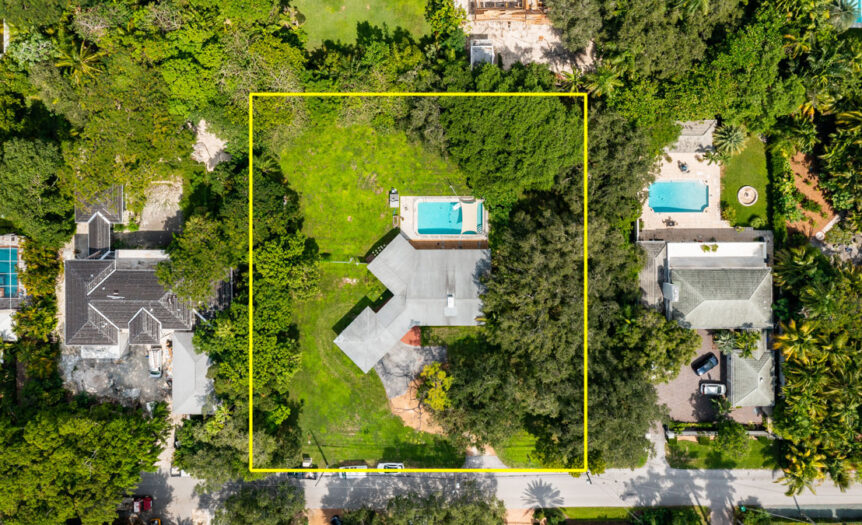Often in a real estate transaction, the survey is one of the last items ordered and completed prior to closing. But here is why you need to stay on top of this and have a Realtor who is savvy enough to understand its implications.
A survey is a certified property boundary report performed by a licensed property surveyor that clearly defines boundaries of the property and the outline of any improvements on the land (i.e., the home). It is really a map of the land and the house. This map can help you determine several important facts.
- Utilities and easements: Almost always, a property is going to have electrical lines running along the rear of the property. Sometimes, utility companies such as Florida Power & Light (FPL) will have an easement on your property. This can be a large electrical box located somewhere on the side or rear of your property. You will need to allow for access to this box by the utility companies for service or repairs. This typically only means you cannot block it off or build something on that small portion of your land. Think about how critical this could be if you were planning to build a guest house in the back corner of your lot, for example. It’s important to know it’s there.
- Fence locations: Fences are often old and varying degrees of “straight” lines, as they have typically been on the property borders for an unknown number of years. Often, a seller isn’t even aware if the fence belongs to them or their neighbor. A survey will depict where the fence lies. Sometimes, buyers (and sellers!) are surprised to find out that their fence is two feet over onto their neighbor’s property! This is important to understand if your intention is to install a new fence. You may need to move it when you pull permits to install a new fence. I have even seen incidences where a credit towards closing costs is given to the buyer at closing to account for this potential issue.
- Room for a pool: Miami seems to be the land of pools! In the city with the second highest number of homes with pools in all the country (according to LendingTree.com), if you actually find a home without one, chances are you’re going to want to know if you have room to add one! By understanding how close the home is to the rear border of the property line, you can then figure out whether the measurement of a pool would fit. Keep in mind, you’ll have to verify each municipality’s rules on setbacks, as you can’t build a pool on the edge of the property.
- Encroachments: Encroachment is another critical item that will show up on a survey. If you don’t have a fence around your property and your neighbor somehow built a pergola that sits two feet within your property, that would be considered an encroachment. This would be noted on the survey. If it is a movable structure, such as a shed, perhaps it is easy to move. But a fixed pergola would be more of a concern. “Some encroachments of mere inches may not seem like a big deal, but others that reach several feet can be a major concern for a buyer, creating potential title issues and even liability issues,” says Alfredo Gonzalez, local real estate attorney with Gunster.
A knowledgeable Realtor and your real estate attorney can help you navigate your options on what to do if you discover any of these concerns on the survey. Just don’t wait until the day before closing to panic order the survey! Ask for a previous copy of a survey from the seller to review and get your new one ordered and completed well in advance of your closing.








 Deering Estate
Deering Estate
 Massage Envy South Miami
Massage Envy South Miami
 Calla Blow Dry
Calla Blow Dry
 My Derma Clinic
My Derma Clinic
 Sushi Maki
Sushi Maki
 Sports Grill
Sports Grill
 The Healthy Kitchen
The Healthy Kitchen
 Golden Rule Seafood
Golden Rule Seafood
 Malanga Cuban Café
Malanga Cuban Café

 Kathleen Ballard
Kathleen Ballard
 Panter, Panter & Sampedro
Panter, Panter & Sampedro
 Vintage Liquors
Vintage Liquors
 The Dog from Ipanema
The Dog from Ipanema
 Rubinstein Family Chiropractic
Rubinstein Family Chiropractic
 Your Pet’s Best
Your Pet’s Best
 Indigo Republic
Indigo Republic




 ATR Luxury Homes
ATR Luxury Homes


 2112 Design Studio
2112 Design Studio
 Hamilton Fox & Company
Hamilton Fox & Company
 Creative Design Services
Creative Design Services
 Best Pest Professionals
Best Pest Professionals
 HD Tree Services
HD Tree Services
 Trinity Air Conditioning Company
Trinity Air Conditioning Company
 Cisca Construction & Development
Cisca Construction & Development
 Mosquito Joe
Mosquito Joe
 Cutler Bay Solar Solutions
Cutler Bay Solar Solutions


 Miami Royal Ballet & Dance
Miami Royal Ballet & Dance
 Christopher Columbus
Christopher Columbus
 Pineview Preschools
Pineview Preschools
 Westminster
Westminster
 Carrollton
Carrollton
 Lil’ Jungle
Lil’ Jungle
 Frost Science Museum
Frost Science Museum
 Palmer Trinity School
Palmer Trinity School
 South Florida Music
South Florida Music
 Pinecrest Orthodontics
Pinecrest Orthodontics
 Dr. Bob Pediatric Dentist
Dr. Bob Pediatric Dentist
 d.pediatrics
d.pediatrics
 South Miami Women’s Health
South Miami Women’s Health

 The Spot Barbershop
The Spot Barbershop
 My Derma Clinic
My Derma Clinic




 Miami Dance Project
Miami Dance Project

 Rubinstein Family Chiropractic
Rubinstein Family Chiropractic
 Indigo Republic
Indigo Republic

 Safes Universe
Safes Universe
 Vintage Liquors
Vintage Liquors
 Evenings Delight
Evenings Delight





 Atchana’s Homegrown Thai
Atchana’s Homegrown Thai
 Baptist Health South Florida
Baptist Health South Florida

 Laser Eye Center of Miami
Laser Eye Center of Miami
 Visiting Angels
Visiting Angels
 OpusCare of South Florida
OpusCare of South Florida

 Your Pet’s Best
Your Pet’s Best





 HD Tree Services
HD Tree Services
 Hamilton Fox & Company
Hamilton Fox & Company


 Creative Design Services
Creative Design Services